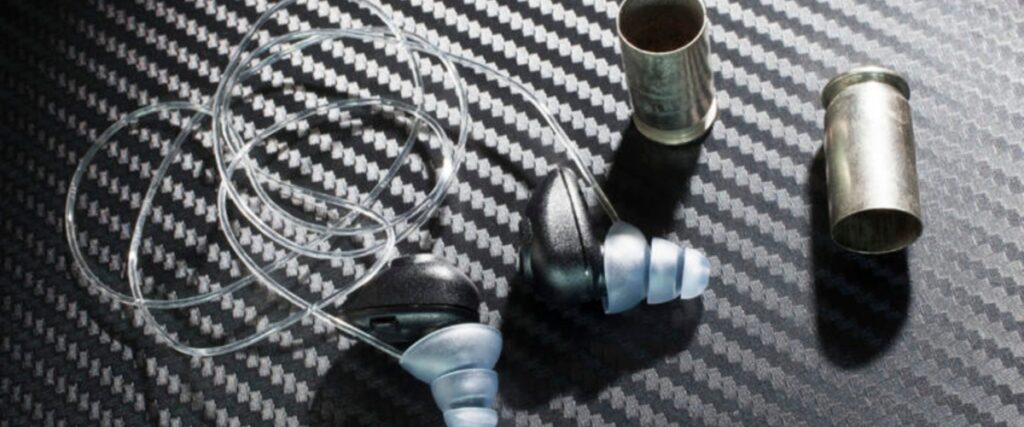
If you’ve visited Triangle Shooting Academy, you know that hearing protection is mandatory when shooting on our range. We encourage everyone to always wear hearing protection when shooting outside as well. There’s good reason. Hearing loss is permanent and today, more than ever, there’s no excuse for not having at least one set of earplugs or earmuffs in your range bag—preferably two.
Hearing protection is available in a variety of styles, sizes and models to fit anyone’s taste and budget. Even those inexpensive “foamies” squeezed into your ears are effective and they’re tiny enough to be an ideal backup if you leave a favorite set at home.
Sooner or later, though, you’ll consider upgrading to earmuffs or advanced electronic versions. Here’s a look at some of the options, their advantages and disadvantages, doubling up and precisely why range safety officers are so strict on the hearing-protection rule.
Hearing Loss
Aging is the primary cause of hearing loss followed by exposure to loud noises, according to the Centers for Disease Control and Prevention (CDC), whose website warns, “Once hearing is gone, it’s gone forever.”
Noise levels above 70 decibels (dB) over a prolonged period, the CDC explains, can affect your hearing and anything above 120 dB could cause immediate damage. To put that into perspective, a whisper measures 30 dB, traffic 80 to 85, power tools 100 and proximity to a first responder siren is 120. Firearms and firecrackers top the list at up to 140 and 165 dB.
The damage is cumulative, too. The CDC explains, “The louder the sound is and the more often a person is exposed to it, the more likely it will damage hearing.”
Ancient Approach
Homer wrote his Greek classic “Odyssey” long before the synthetic material in today’s foamies was invented. When he fashioned beeswax into ear plugs for the seamen in his tale (to avoid the fatal siren’s song) it may’ve been the first mention of hearing protection in history. Ironically, those ear stuffing plugs, foam ones anyway, are incredibly effective.
Good sets provide incredible sound reduction and they are inexpensive. Today they come in a variety of colors, patterns and even corded for retention during breaks from the firing line. The tiny, lightweight gems don’t even get in the way when you’re trying to establish a proper cheek weld on a rifle. Some people, however, seem to feel a slight “pressurized” sensation when they’re worn.
Earmuffs for Shooters
Non-electronic earmuffs are another budget-friendly option. They can be quite effective, although there are some considerations to keep in mind—including comfort. Earmuffs can squeeze full faces into an uncomfortable pucker, for example, although a more common complaint is pressure from the headband after long range sessions. Those tight sealing gaskets along your ears also trap heat, which can be annoying outdoors during the summer.
There’s also bulk at your ears, which can interfere. It’s no problem for handgun shooters, but trying to get your cheek weld on a rifle stock well enough to align the sights can be a challenge.
Electronic Earmuffs
Some earmuffs have electronics that filter or clip loud noises, yet allow entry or even amplification of conversation and range commands. The technology is amazingly effective and a great added safety measure regardless of firing line location.
Microphones can be located on both sides or only one, and volume controls let you dial things down if that range officer is retired-Marine-Corps-drill-instructor loud. Considerations are identical to the non-electronic versions, but there’s also care and feeding of the power source. If you go with this slightly more expensive style, keep a spare set of batteries in your range bag.
Tiny, Discreet and Effective
They look like hearing aids, but manufacturers are now making a cutting-edge breed of miniaturized electronic versions that retain the efficiency of foamies, but add the versatility of noise clipping and selective amplification. Volume is controllable and there’s no concern when shouldering a longer firearm.
These are usually the most expensive models available today. Batteries run from exotic and hard-to-find cells to hearing-aid versions available at most stores. Check before you buy.
Noise-Reduction Rating (NRR) and Doubling Up
Companies use American National Standards Institute (ANSI) guidelines to establish a numeric rating on their hearing protection. As the number increases, the amount of noise reaching your ears decreases.
The NRR reflects dB reduction, with some math. Subtract seven from the NRR and divide by two to determine effective drop in noise. A set rated at 31 would therefore block 12 dB. If you double up—foamies at a 33 rating underneath earmuffs at 31—reduction is calculated by simply adding five to the NRR rating of the highest set. The aforementioned pair would, therefore, reduce dB level by 38 (33+5).
Doubling up is highly recommended when “big boomers” are on an indoor range or wear a muzzle brake. It’s a great bonus for new shooters, too, who might otherwise be tempted to flinch when a firearm goes off or, worse yet, think twice about joining friends and family at the next range session.
Let Us Help
Our team of firearms experts can help you determine which hearing protection options are best for you. Stop by Triangle Shooting Academy today, and we’ll be happy to answer all your questions.
Follow Us
Keep up with the latest updates on our Facebook and Instagram accounts.
